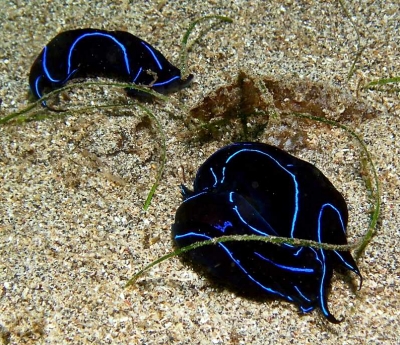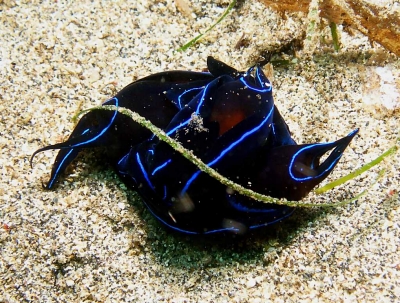Chelidonura varians - mating behaviour
September 19, 2007
From: Kamal El Tawil

Dear Bill :
On a recent dive trip in Manado, I noticed two Chelidonura varians approaching each other and joining. A moment later a third one joined. Is this common behaviour ? Would you say that is mating ?
Locality: Bunaken marine park, Manado, 5 meters, North Sulawesi , Indonesia, Celebes sea, 13 August 2007, Sandy bottom. Length: 30 mms. Photographer: Kamal El Tawil.
How would you relate the second picture in Danny van Belle's message #19283? I think it involves more than two slugs too.
Kind regards,
Kamal el Tawil
www.coralworld.net
kamal@coralworld.net
El Tawil, K., 2007 (Sep 19) Chelidonura varians - mating behaviour. [Message in] Sea Slug Forum. Australian Museum, Sydney. Available from http://www.seaslugforum.net/find/20748
Dear Kamal,
Looking through earlier messages on this species, there are a number of observations of three animals 'pairing'. Like all sea slugs, species of Chelidonura are hermaphrodite, with fully functional male and female reproductive systems. In nudibranchs, the male and female organs open together on the right side of the body so for physical reasons only two animals can mate at one time, but when they do so they can act as both male and female at the same time. However in aglajids, like Chelidonura, and in Sea Hares, the male organ - the penis - is situated on the right side of the head, while the female opening is at the posterior end of the body on the right side. This means that when a pair mate, one usually acts as the female, and the other as the male. It also means that if there are more than two animals present they can form a mating chain with the one at the front acting as a female, the one at the back acting solely as a male, but the one[s] in the middle can act as both.
This is discussed more fully on the Mating Chains Fact Sheet. In the messages attached to that Fact Sheet you will see a number on what has been called the Sea Hare Love Drug which is a chemical signal Sea Hares produce when mating. It is possible that aglajids produce a similar chemical signal which would explain why two animals together can quickly attract a third - or more.
Best wishes,
Bill Rudman
Related messages
-
Chelidonura varians - laying eggs in an aquarium.
From: Kim Schrier, April 21, 2010 -
Re: Chelidonura varians in aquarium
From: Robin Jerome, December 3, 2009 -
Re: Chelidonura varians in aquarium
From: Bill Brown, August 26, 2009 -
Re: Chelidonura from Mayotte, Indian Ocean
From: Sylvain Le Bris, January 30, 2009 -
Re: Chelidonura varians in aquarium
From: Beck None, October 7, 2008 -
Philinopsis gardineri? from the Red Sea
From: Dany Porras, July 26, 2007 -
Chelidonura varians - strange behavior
From: Erwin Kodiat, June 22, 2007 -
Chelidonura varians from Bali
From: Danny Van Belle, January 26, 2007 -
Chelidonura varians from sthn Queensland
From: Ian Banks, May 4, 2006 -
Mating Chelidonura varians
From: Erwin Kodiat, January 16, 2006 -
Chelidonura varians from Bali
From: Erwin Kodiat, December 6, 2005 -
Chelidonura varians mating
From: Mary Jane Adams, February 14, 2005 -
Chelidonura varians in aquarium
From: tlp, December 4, 2003 -
Chelidonura varians from Sabah, Malaysia
From: Asther M. Lau, September 6, 2003 -
Re: Chelidonura varians - shipping stresses?
From: James Urquhart, June 25, 2003 -
Re: Chelidonura varians - shipping stresses?
From: James Urquhart, June 24, 2003 -
Chelidonura varians - shipping stresses?
From: James Urquhart, May 28, 2003 -
Re: Chelidonura varians - trailing behaviour
From: Roberto Sozzani, May 21, 2003 -
Re: Chelidonura varians - trailing behaviour
From: Roberto Sozzani, May 20, 2003 -
Chelidonura varians - trailing behaviour
From: Leanne & David Atkinson, May 19, 2003 -
Chelidonura varians egg laying
From: Joe Yaiullo, April 22, 2003 -
Chelidonura varians - larval culture
From: Joe Yaiullo, April 9, 2003 -
Chelidonura varians from Lord Howe Island
From: W.B. Rudman, January 9, 2003 -
Chelidonura varians - Mabul Island, Malaysia
From: Richard Houghton, September 3, 2002 -
Aquarium flatworm control
From: Victor Hernandez, April 3, 2002 -
Chelidonura varians from Indonesia
From: Stuart Hutchison, March 9, 2002 -
Re: Slug to control photosynthetic flatworms
From: Patrick Webb, March 9, 2002 -
Re: Slug to control photosynthetic flatworms
From: Mark, January 25, 2002 -
Re: Need Slug that will help with Flatworms
From: joe, September 7, 2001 -
Slug to control photosynthetic flatworms
From: Darrell Gibson, September 7, 2001 -
Need Slug that will help with Flatworms
From: D. Scott Morrison, June 17, 2001 -
Juvenile Chelidonura from SE Sulawesi
From: Lindsay Warren , June 13, 2001 -
Planaria-eating nudibranch?
From: Drew Dram, April 2, 2001 -
Chelidonura feeding observations
From: Julian Sprung, December 22, 2000 -
Re: Where to get Chelidonura varians
From: Scott Crumpton, June 10, 2000 -
Re: Where to get Chelidonura varians
From: Gary J. Robinson, February 14, 2000 -
Re: More on Chelidonura feeding
From: Cory Pittman, February 8, 2000 -
A nudibranch that eats Flat Worms
From: john, December 10, 1999 -
control of flatworms in marine aquarium
From: Roger, May 29, 1999 -
Red flatworm-eating Sea Slug
From: pat, April 14, 1999 -
Re: Where can I get Chelidonura varians?
From: Donna Stimetz, March 29, 1999 -
Where can I get Chelidonura varians?
From: Paul Hranitz, November 30, 1998 -
Chelidonura feeding
From: Davide & Giovanni, October 14, 1998 -
Reference for Chelidonura feeding
From: Davide Giovine, October 8, 1998 -
More Chelidonura feeding
From: Cory Pittman, October 7, 1998 -
Re: Chelidonura feeding
From: Peter Firminger, September 18, 1998 -
Chelidonura feeding
From: Davide & Giovanni, September 8, 1998
